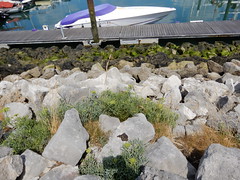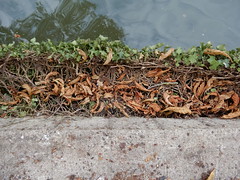At Gosport, we ended up going to a marina cafe. Just outside, the sloped seabreak of stacked rocks was showing a graduated tint of waterfront greenery, from bladderwrack at the base to sea cabbage at the top:


Note the interval of bare rocks between the sections showing plant growth. This is self-planted, I'm assuming, and that section in the middle will not have much for plants to snag on. You could pack those gaps with gravel or soil, but this will act as a lubricant and made the downwards movement of the rock-pile over time more likely; and roots in that section will loosen the balance connections between the boulders. Better probably to work with the bare space and treat it just as another texture.
Here's a very different body of water, the Thames at Oxford:


Ivy grows very freely along the retaining wall, and has to be cut back regularly. Here a hard cut back from the path edge has left a mat of ivy with no support from above, and it has peeled away under the force of its own weight.


Note the interval of bare rocks between the sections showing plant growth. This is self-planted, I'm assuming, and that section in the middle will not have much for plants to snag on. You could pack those gaps with gravel or soil, but this will act as a lubricant and made the downwards movement of the rock-pile over time more likely; and roots in that section will loosen the balance connections between the boulders. Better probably to work with the bare space and treat it just as another texture.
Here's a very different body of water, the Thames at Oxford:


Ivy grows very freely along the retaining wall, and has to be cut back regularly. Here a hard cut back from the path edge has left a mat of ivy with no support from above, and it has peeled away under the force of its own weight.
No comments:
Post a Comment